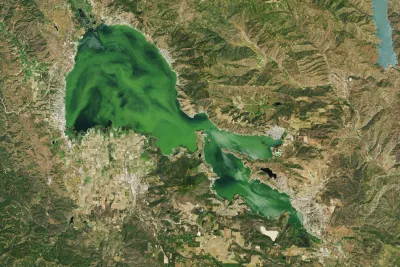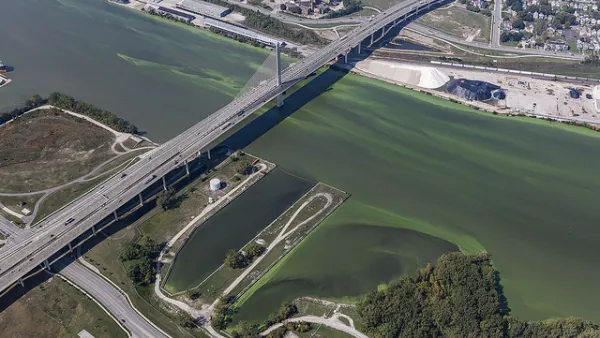A potentially toxic algal bloom has turned Clear Lake in Northern California bright green, fed by increased runoff from human activity.

“Clear Lake, one of California’s oldest and most-visited lakes, is not so clear anymore after an algal bloom turned the water cloudy and green,” reports Terry Castleman for the Los Angeles Times. Located about 60 miles north of the San Francisco Bay, the 43,000-acre freshwater lake is a popular destination for boaters, fishers, and swimmers, but those activities will likely be affected for weeks to come.
The bloom may be comprised of blue-green algae, also known as cyanobacteria, which produce a toxin that can irritate the skin and cause liver and kidney damage. According to Nasa, “Algal blooms have been common in Clear Lake’s long history, but have grown more common with human activity in the last century,” including runoff from nearby farms, vineyards, faulty septic systems, gravel mines, and an abandoned open-pit mercury mine, as well as from nonnative carp stirring up the nutrients in the lake bed’s sediment.
Cyanobacteria is the same type of toxic algae that has bloomed extensively in Lake Erie over the last several years, most notably in 2014 when residents in Toledo, Ohio, were unable to drink, cook with, or brush their teeth with water for three days. States across the country are dealing with algae blooms due to nutrient run-off, impacting local water quality and water-based tourism, including Cape Cod.
FULL STORY: Shocking before-and-after photos show California’s famed Clear Lake turn bright green

National Parks Layoffs Will Cause Communities to Lose Billions
Thousands of essential park workers were laid off this week, just before the busy spring break season.

Retro-silient?: America’s First “Eco-burb,” The Woodlands Turns 50
A master-planned community north of Houston offers lessons on green infrastructure and resilient design, but falls short of its founder’s lofty affordability and walkability goals.

Delivering for America Plan Will Downgrade Mail Service in at Least 49.5 Percent of Zip Codes
Republican and Democrat lawmakers criticize the plan for its disproportionate negative impact on rural communities.

Test News Post 1
This is a summary

Test News Headline 46
Test for the image on the front page.

Balancing Bombs and Butterflies: How the National Guard Protects a Rare Species
The National Guard at Fort Indiantown Gap uses GIS technology and land management strategies to balance military training with conservation efforts, ensuring the survival of the rare eastern regal fritillary butterfly.
Urban Design for Planners 1: Software Tools
This six-course series explores essential urban design concepts using open source software and equips planners with the tools they need to participate fully in the urban design process.
Planning for Universal Design
Learn the tools for implementing Universal Design in planning regulations.
EMC Planning Group, Inc.
Planetizen
Planetizen
Mpact (formerly Rail~Volution)
Great Falls Development Authority, Inc.
HUDs Office of Policy Development and Research
NYU Wagner Graduate School of Public Service





























